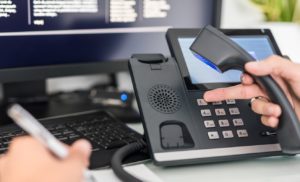You’ve heard a lot about VoIP, or Voice over Internet Protocol. It saves money while giving you features that the traditional phone network can’t provide. But just what is it, really? How does it work?
The short answer is that it’s digitized sound sent over the Internet. A device at your end samples what you’re saying and converts it to bits. It gets bits back and converts them to sound. But what makes it useful is that you can treat it just like a phone call. You can call landline phones from your VoIP phone, and they can call you. You can make calls between phones from different manufacturers or use an application on your smartphone or desktop computer.
The office VoIP network
An office phone network, whether it’s based on traditional or VoIP technology, is called a private branch exchange or PBX. The Internet version is called an IPBX. Its central equipment can be in the office, in a remote data center, or in the cloud. VoIP phones are connected to the PBX over data connections such as Wi-Fi and Ethernet. Sometimes the phones use the same local network as the computers; sometimes they use a separate network for more consistent quality.
Either way, your phone converts what you say into data and sends it to the IPBX, which is really just a server running specialized software. If the equipment is based in your office, your call goes out onto the public telephone system when it leaves the building. If it’s cloud-based, your voice may travel almost the entire distance as data, saving the cost of a long-distance call.
The conversion to data uses compression techniques, so the bandwidth needed for one conversation isn’t very high. If an office has a lot of phones, though, it needs to have enough bandwidth to let many conversations keep up and should have a router with VoIP-friendly features.
You may have heard of VoIP phones referred to as SIP phones. SIP is one of two common protocols for making VoIP connections. The other is called H.323. The phone has to be compatible with the protocol your exchange uses, but phones from different manufacturers for the same protocol are interchangeable.
You don’t actually have to give up your old phone. Devices called Analog Telephone Adapters (ATAs) let you plug in one or more ordinary telephones and convert their audio signals to data. It’s less expensive than buying VoIP phones, but not all the features are available.
What happens when you make a call?
When you place a call, you might hear touch tones, but they’re just to give a sense of familiarity. The keys you press are converted to data, and the exchange determines whether you’re making an in-office call or outside call. If the call is within the IPBX’s area, it handles the whole connection. It isn’t restricted to voice data in this case; many IPBXs can carry video and documents as well. The ability to combine these is called “Unified Communication.”
If the call goes through a cloud-based service, it may emerge on the public telephone network only at a point local to the receiving party — possibly in another nation. If you’re calling another VoIP exchange, the call may not have to go over the public network at all. Sending data is very inexpensive, so VoIP calls cost much less than regular long-distance calls.
To get a clean-sounding conversation, you need an Internet connection that has enough bandwidth and will move the data along at a consistent speed. A poor connection may sound choppy, parts of the conversation may drop out, or you may hear an echo. Equipment which is designed to deliver “QoS” (quality of service) for voice data will reduce the incidence of problems.
If you want to learn more
Several websites have good introductions to VoIP for the non-technical reader. Here are a couple to look at:
- Introduction to VoIP (VoIP Review)
- An Introduction to Voice over IP (VoIP) (Lifewire)
Whatever you need to run on your network, SystemsNet keeps it running. Contact us for details.
